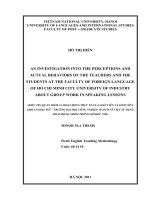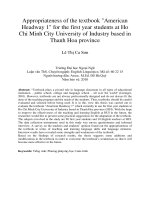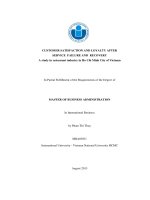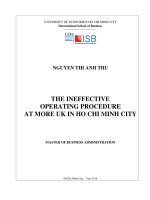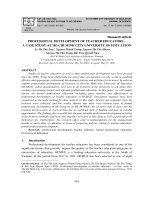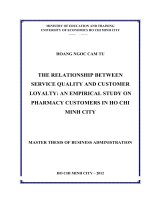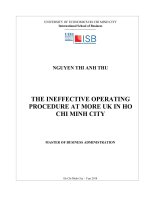Evaluating the textbook “law” a study at faculty of law ho chi minh city university of technology
Bạn đang xem bản rút gọn của tài liệu. Xem và tải ngay bản đầy đủ của tài liệu tại đây (2.59 MB, 133 trang )
MINISTRY OF EDUCATION AND TRAINING
HO CHI MINH CITY UNIVERSITY OF TECHNOLOGY
-----------------
EVALUATING THE TEXTBOOK “LAW”
A STUDY AT FACULTY OF LAW- HO CHI
MINH CITY UNIVERSITY OF TECHNOLOGY
Submitted to the
Faculty of English language
in partial fulfillment of the Master’s degree in English language
Course code: 1641900
By
NGUYEN HUYEN QUANG
Supervised by
NGUYEN THI KIEU THU, PHD
HO CHI MINH CITY, March 2018
CERTIFICATION OF THESIS DEFENSE
THE THESIS WAS WRITTEN AT
HOCHIMINH CITY UNIVERSITY OF TECHNOLOGY
Academic supervisor: Nguyễn Thị Kiều Thu, Ph.D
The thesis defense session was conducted at Ho Chi Minh City University of
Technology (HUTECH) on 6th April, 2018.
The Board of Examiners for the Master’s Thesis Defense
TT
1
2
3
4
5
NAME
Lê Thị Thanh, Ph.D
Nguyễn Đăng Nguyên, Ph.D
Trần Quốc Thao, Ph.D
Lê Văn Tuyên, Ph.D
Nguyễn Hòa Mai Phương, Ph.D
FUNCTION
Chair
Reader 1
Reader 2
Member
Secretary Member
On behalf of the Board of Examiners
Chair
Lê Thị Thanh, Ph.D
HCMC UNIVERSITY OF TECHNOLOGY
POSTGRADUATE INSTITUTE
Ho Chi Minh City, April 2018
MASTER’S THESIS TASK REPORT
Student name: Nguyen Huyen Quang
Sex:Female
Date of birth: 30th March, 1988
Place of birth: Binh Dinh
Major: English Language
Student code: 1641900023
I- Thesis title:
Evaluating the textbook “Law”- A study at Faculty of Law, Ho Chi Minh City
University of Technology.
II- Task description and contents:
This study focuses on an evaluation of the textbook “Law” that based on the
evaluation of students of law at Faculty of Law-HUTECH.
On the basis of the data collected from a survey based on questionnaire for
law students, findings about the suitability of the textbook “Law” for the students’
needs as well as the local needs were drawn out. However, a number of aspects of
the textbook “Law” were found to be necessarily adjusted and the recommendations
were made.
III- Starting date: 01st August, 2017.
IV- Completing date: 18th March, 2018.
V- Academic supervisor: Nguyen Thi Kieu Thu, Ph.D.
SUPERVISOR
FACULTY DEAN
Nguyen Thi Kieu Thu, Ph.D
Nguyen Thi Kieu Thu, Ph.D
i
CERTIFICATE OF ORIGINALITY
I certify my authorship of the thesis submitted today entitled:
Evaluating the textbook “Law”- A study at Faculty of Law – Ho Chi Minh
City University of Technology.
In terms of the statement of Requirements for Theses in Master’s Programs
issued by the Higher Degree Committee of Faculty of English language, Ho Chi
Minh City University of Technology.
Ho Chi Minh City, March 2018
Nguyễn Huyền Quang
ii
RETENTION AND USE OF THE THESIS
I hereby state that I, Nguyen Huyen Quang, being the candidate for the
degree of Master of Art (English Language), accept the requirements of the
University relating to the retention and use of Master’s Theses deposit in the
Library.
In terms of these conditions, I agree that the original of my thesis deposited
in the Library should be accessible for purposes of study and research, in
accordance with the normal conditions established by the Librarian for the care,
loan and reproduction for theses.
Ho Chi Minh City, March 2018
Signature:
Nguyễn Huyền Quang
iii
ACKNOWLEDGEMENTS
My special thanks are due to all those who have made great contributions to
the preparation and completion of the thesis.
First and foremost, I would like to express my deepest gratitude to my thesis
supervisor, Ms Nguyen Thi Kieu Thu, Ph.D, for her constant guidance and
invaluable detailed comments on every chapter of the thesis. Without her support
and guidance, this thesis would never have been completed.
I am also very grateful to Mr Nguyen Dang Nguyen, Ph.D, who gave me
priceless advice and assistance in the process of doing the research.
In addition, I would like to thank the Faculty of Law – Ho Chi Minh City
University of Technology for organizing the extracurricular activity in teaching
Legal English.
I would like to express my gratitude to the Legal English teachers of
University of Law of Ho Chi Minh City, Human Resources Managers and staffs of
YKVN, KevinChia, Phuoc& Partners, KPMG, Unilever for their enthusiastic
participation in the survey and their permission for the information to be used.
I am also thankful to the law students, who were joining in the course and
were willing to give their own opinions and make useful suggestions for the
textbook “Law”.
Last, but not least, I warmly thank my family for their encouragement and
help.
iv
ABSTRACT
Legal English is a new branch at Faculty of Law of Ho Chi Minh City
University of Technology that has not included in the curriculum of Faculty of Law.
As a new branch, the textbook “Law” in the series of Career Paths of Express
Publishing has been first applied as the extracurricular activity for the Faculty. With
an aim to improve the quality of the textbook “Law”, this study focuses on an
evaluation of the textbook “Law” that based on the evaluation of students of law in
terms of aims and approaches, format and organization, illustration, topics,
accompanying materials, language contents, language skills and activities contained
in this textbook.
The main method of this research was mixed method design which includes
both qualitative and quantitative data.
On the basis of the data collected from a survey based on questionnaire for
law students, findings about the suitability of the textbook “Law” for the students’
needs as well as the local needs were drawn out.
However, a number of aspects of the textbook “Law” were found to be
necessarily adjusted and the recommendations were made.
Key words: ESP; Textbook; Material evaluation.
v
TABLE OF CONTENTS
CERTIFICATE OF ORIGINALITY....................................................................... i
RETENTION AND USE OF THE THESIS ...........................................................ii
ACKNOWLEDGEMENTS .................................................................................... iii
ABSTRACT .............................................................................................................. iv
TABLE OF CONTENTS .......................................................................................... v
LIST OF TABLES ................................................................................................ viii
Chapter 1: INTRODUCTION ................................................................................. 1
1.1.
Background to the study ..............................................................................1
1.2.
Problem statement .......................................................................................2
1.3.
Purpose of the study ....................................................................................3
1.4.
Thesis statement ..........................................................................................3
1.5.
Scope of the study ........................................................................................3
1.6.
Significance of the study..............................................................................4
1.7.
Limitations of the study ...............................................................................4
1.8.
Organization of the study ............................................................................5
CHAPTER 2: LITERATURE REVIEW ................................................................ 6
2.1.
English for Specific Purposes (ESP) ...........................................................6
2.1.1. Overview of English for Specific Purposes ............................................6
2.1.2. Relationship between General English (GE) and English for Specific
Purposes (ESP) ....................................................................................................7
2.1.3. Legal English and its characteristics .......................................................9
2.2.
Materials ...................................................................................................12
2.2.1. Definition of materials ..........................................................................12
2.2.2. Materials evaluation criteria..................................................................13
2.2.3. Components of good materials .............................................................14
2.2.4. Materials for legal English ....................................................................17
2.3.
Materials evaluation .................................................................................21
2.3.1. Definition of materials evaluation.........................................................21
vi
2.3.2. Purpose of materials evaluation ............................................................21
2.3.3. Framework for materials evaluation .....................................................22
2.3.4. Conceptual framework for materials evaluation in the current study ...26
CHAPTER 3: METHODOLOGY ......................................................................... 28
3.1. Research question ..........................................................................................28
3.2. Research design .............................................................................................28
3.3. Research site ..................................................................................................29
3.4. Description of the textbook “Law” ................................................................30
3.5. Sample and sampling procedures ..................................................................31
3.5.1. Selection of participant ...........................................................................31
3.5.2. Characteristics of participant ..................................................................32
3.5.3. Research instrument ................................................................................32
3.6. Data collection procedures ............................................................................34
3.7. Data analysis procedures ...............................................................................34
CHAPTER 4 ............................................................................................................ 36
RESULTS AND DISCUSSIONS ........................................................................... 36
4.1. Introduction ....................................................................................................36
4.2. Results ............................................................................................................36
4.2.1. Aims and approaches (Question 1, 2, 3, 4) .............................................36
4.2.2. Formats and organizations of the textbook (Question 5, 6, 7, 8) ............40
4.2.3. Illustrations of the textbook (Question 9, 10) .........................................45
4.2.4. Accompanying materials (Question 11) .................................................47
4.2.5. Topics (Question 12, 13, 14) ...................................................................47
4.2.6. Language contents (Question 15, 16, 17, 18, 19) ...................................50
4.2.7. Skills (Question 20, 21, 22, 23) ..............................................................55
4.2.8. Activities (Question 24, 25, 26, 27, 28, 29, 30) ......................................58
4.2.9. Students’ expectations about the textbook ..............................................64
4.3. Discussions on remarkable strengths and weaknesses of the textbook “Law”
...............................................................................................................................66
vii
CHAPTER 5: RECOMMENDATIONS AND CONCLUSION ......................... 75
5.1. Recommendations ..........................................................................................75
5.1.1. Recommendations from opinions of law students ..................................75
5.1.2. Recommendations from stakeholders .....................................................77
5.1.2.1. Recommendations from Legal English teachers' opinions ..............77
5.1.2.2. Recommendations from the administrator' opinions .......................78
5.1.2.3. Recommendations from enterprises' opinions .................................80
5.1.3. Synthesis of recommendations................................................................81
5.2. Conclusion ......................................................................................................82
REFERENCES ........................................................................................................ 84
APPENDIX 1: ............................................................................................................ 1
DESCRIPTION OF 15 UNITS IN THE TEXTBOOK “LAW”............................ 1
APPENDIX 2: ............................................................................................................ 5
SAMPLE LESSON PLAN ....................................................................................... 5
APPENDIX 3: QUESTIONNAIRE (Vietnamese Version) ................................. 13
APPENDIX 4: QUESTIONNAIRE (English Version) ........................................ 18
APPENDIX 5: .......................................................................................................... 22
REPLACEMENT TEST TO ENTER THE TRIAL LEGAL ENGLISH CLASS22
APPENDIX 6: .......................................................................................................... 27
EXAMPLES ON LATIN TERMS ......................................................................... 27
APPENDIX 7: .......................................................................................................... 31
EXAMPLES ON OLD-FASHIONED WORDS................................................... 31
viii
LIST OF TABLES
Table 4.1. Should Legal English be included in legal curriculum as a main subject?36
Table 4.2. Which year of students can study Legal English? ................................... 38
Table 4.3. Legal English should focus on particular section? Give reasons............. 38
Table 4.4. The textbook is suitable to students' need in studying Legal English. .... 39
Table 4.5. The content in each lesson is clear. .......................................................... 41
Table 4.6. Reading comprehension, vocabulary, listening, speaking, writing sections
are ordered logically. ................................................................................................. 42
Table 4.7. The textbook reminds in knowledge for learners to review. ................... 43
Table 4.8. The textbook reminds in knowledge for learners to review. ................... 44
Table 4.9. Illustrations are very attractive. ................................................................ 45
Table 4.11. The illustrations are functional in involving your attention to the lesson
content ....................................................................................................................... 46
Table 4.12. Speed of recordings is suitable for your comprehension. ...................... 47
Table 4.13. The topics meet your interests. .............................................................. 48
Table 4.14. The topics are interesting. ...................................................................... 49
Table 4.15. The topics offer the possibility of enriching your awareness of your
Legal English. ........................................................................................................... 49
Table 4.16. The textbook offers hands-on experience when practicing legal English.50
Table 4.17. The textbook offers enough a number of necessary grammatical
structures. .................................................................................................................. 51
Table 4.18. The language in the textbook helps learners understand obviously the
Lawyers' communication in the practicing law......................................................... 52
Table 4.19. The textbook provides enough the necessary specific vocabulary used in
law. ............................................................................................................................ 53
Table 4.20. The specific vocabulary in the textbook meets students' needs in
studying Legal English. ............................................................................................. 54
Table 4.21. Reading section is suitable to learners' level. ........................................ 55
Table 4.22. Listening section is suitable to learners' level. ....................................... 56
ix
Table 4.23. Speaking section is suitable to learners' level. ....................................... 57
Table 4.24. Writing section is suitable to learners' level. ......................................... 58
Table 4.25. The activities in the textbook help learners improve their language
skills. ......................................................................................................................... 58
Table 4.26. The activities in the textbook help learners improve their practicing in
law. ............................................................................................................................ 60
Table 4.27. The activities in the textbook help learners review their knowledge from
previous lessons. ....................................................................................................... 61
Table 4.28. The activities in the textbook help learners feel more confident. .......... 62
Table 4.29. Pair work, group work, individual work is suitable to your English
level. .......................................................................................................................... 63
Table 4.30. In your opinion, in the textbook “Law” which section…? .................... 64
Table 4.31. Which items in the textbook "Law" do students like the best? ............. 64
Table 4.32. Which items in the textbook "Law" do students not interested in? ....... 65
x
LIST OF ABBREVIATIONS AND SYMBOLS
EAP
English for Academic Purposes
EEP
English for Educational Purposes
EOP
English for Occupational Purposes
ESP
English for Specific Purposes
GE
General English
HUTECH
Ho Chi Minh City University of Technology
1
Chapter 1: INTRODUCTION
Nowadays, the term “Legal English” is no longer strange to people in the
world. Legal English can be easily understood as English taught for Law which is
taught for both law students and law practitioners. Over the last few decades, there
has been an expansion of commercial activities across national territory. As a matter
of fact, Legal English has already become a global language that achieved by
parties who join in commercial activities. It is a fact that Legal English can achieve
a lot of benefits from using it. People who possess a good Legal English can have
many opportunities to choose a good job and conditions of working environment.
This chapter presents the background to the study including the development
of English in Vietnam and Ho Chi Minh City, and the role of Legal English at work,
followed by the indispensable parts of any study: the problem statement, the
purpose, the limitations, and finally the organization of the study. Also included in
this chapter is the description of the textbook “Law” which is taught at Ho Chi
Minh City University of Technology.
1.1.
Background to the study
Vietnam has not developed yet in terms of economy when the people had
just overcome the damages caused by the war. During this time, the Vietnamese
Government applied the closed-door policy, which prohibited any economic deals
with any foreign countries except for the Soviet Union and the socialist countries,
and the State subsidized most of the home projects. Consequently, people had not
taken much care of legal field.
It was a turning point when Vietnam officially joined in the WTO in 2006
and a wide range of foreign companies have invested in Vietnam. They have
realized that Vietnam has a convenient environment in terms of geography and low
labor cost. Besides, a number of home companies have exported their products to
many countries in the world. In such a context, it is crucial for foreign companies to
have knowledge of Vietnamese laws and vice versa, and for Vietnamese companies
to have knowledge of international laws.
2
Being the city whose economy is considered the leading of the country, Ho
Chi Minh City is home for a large number of foreign and Vietnamese companies
and representative offices of multinational corporations. It is important for these
agents to be aware of the regulations of Vietnamese Government regardless of
whether foreigners could be permitted to conduct their business in our territory or
not. Only do when they certainly have legal knowledge that they would get a high
promotion and bring the reputation both for their own companies and nation. If a
company is not good at legal systems of the countries in which they are dealing
with, it would be dangerous for their business in drafting contracts, writing legal
documents that could make mistakes caused by lacking of legal perceptions. Hence,
it is necessary to pay attention to legal English and its roles in legal studies for
lawyers and other legal officers who work in law field to apply in their practicing.
According to Tiersma (1999), Legal English refers to the type of English
used in legal writing. It has been referred to as a “sublanguage”, as legal English
differs from ordinary language in vocabulary, morphology, syntax and semantics, as
well as other linguistic features. It is a technical language specifically originated as
a language for legal professionals such as judges, lawyers, legal assistants and
attorneys. A specialized use of certain terms and linguistic patterns governs the
teaching of legal language. Thus, studying legal language is as a kind of second
language, a specialized use of vocabulary, phrases, and syntax that helps users such
as judges, lawyers, legal assistants and attorneys to communicate more easily with
one other with accuracy and precision.
1.2.
Problem statement
It is necessary for Vietnamese lawyers, legal officers as well as people who
work in law fields to be good at legal English to give appropriate consultancy to
foreign investors as well as Vietnamese enterprises when they wish to invest in
newly emerging business lines or other legal fields. However, there exists a problem
that not many Vietnamese people who work in the law field can possess substantial
legal English knowledge. Consequently, there is an urgent need to train those
3
working in the law field in such a way that they could communicate in English at
work.
On the other hand, not many Law universities in Ho Chi Minh City offer
Legal English into their curriculum for law students. It is only Law University of
Ho Chi Minh City and Faculty of Law of Huflit University that apply this subject as
a main one to their curriculum. However, when teaching this subject, teachers have
to search information on the Internet and refer to foreign books to adapt them to
Legal Contexts of Vietnam instead of using an original textbook. In the Faculty of
Law of HUTECH University, Legal English is considered as important but it has
not been taught yet because there is a lack of Legal English materials.
In the Vietnamese context, there are a number of studies which evaluate
General English materials but it is in lack of studies which evaluate English for
Specific Purposes materials, Law in particular.
1.3.
Purpose of the study
This study aims to evaluate the textbook “Law” of Express Publishing to find
out whether it is suitable for the students and whether it meets the target needs or
not in terms of aims and approaches, format and organization, illustration, topics,
accompanying materials, language contents, language skills and activities.
1.4.
Thesis statement
Based on the fact that Legal English is a new subject at the Faculty of Law-
HUTECH University and there are not many standard Legal English textbooks, this
study attempts to survey the students’ attitude toward the material and to reveal
whether it satisfies the employment requirements in the area of Ho Chi Minh City.
The research is guided by the following question:
How do the students of Faculty of Law – HUTECH evaluate the textbook
“Law”?
1.5.
Scope of the study
In the scope of this study, the author only used the textbook “Law” in the
series of Career Paths of Express Publishing for the reason that this textbook has
4
been applied for the first time at the university; therefore, students’ evaluation is
very important after the first application of the textbook.
Moreover, the author only sought for answers about students’ evaluation
toward the textbook “Law” in terms of its physical appearances, its language
contents, skills and activities. The study does not try to give empirical evidence of
its effectiveness in improving proficiency of English for students.
1.6.
Significance of the study
This study contributes to the background theory of materials evaluation by
investigating how law students of Faculty of Law of HUTECH evaluate the
textbook “Law”.
The result of this study would help teachers, students and the university
administrators not only know the crucial role of Legal English, help design the
English courses in the Faculty of Law- so that the law students could effectively
communicate in English at work, but also find out whether the textbook “Law” in
Career Path could be used in teaching in reality or not. Hence, the study might have
a useful insight towards the textbook so that teachers will use and adapt the
textbook more effectively.
1.7.
Limitations of the study
As for the participants, the amount who joined in the survey is comparatively
small - only 37, which is considered a disadvantage in getting the research subjects’
responses to questionnaire. On the other hand, the Faculty of Law of HUTECH has
been newly established in 2014. Thus, at the conducting time to do this thesis, there
are not fourth-year students and nor alumi to evaluate their using Legal English in
their job.
Another disadvantage of the survey is the limited number of teachers
involving in teaching the textbook “Law”. There are not any teachers who teach this
textbook before the experiment teaching described in this study. Besides, there are
only three teachers in Ho Chi Minh City who specialize in teaching legal English.
5
1.8.
Organization of the study
This study consists of five chapters:
Chapter One presents the introduction of the study. In this chapter, the
background to the study, the problem statement, the purpose of the study, the
description of the textbook “Law”, and the limitations of the study are included.
Chapter Two covers an overview of English for Specific Purposes (ESP),
especially Legal English, the characteristics of Legal English, the issues related to
the materials in general and materials evaluation in particular, typically materials
for Legal English. The final part of this chapter is the presentation of the framework
for materials evaluation including the criteria for evaluating materials, especially
English for Specific Purposes materials.
Chapter Three focuses the methodology of the research. Apart from the
research questions, this chapter presents the research designs, which included the
method of the study, accordingly, qualitative with descriptive statistics method was
employed. This chapter also refers to the sample and sampling procedure including
the selections and characteristics of the participant, the description of the research
subject. The author also describes in detail the research instrument used for
collecting data, which is questionnaire. For ending this chapter, the procedures of
data collection and analysis were mentioned.
Chapter Four, is divided into three parts: introduction, results from the
responses to the questionnaires collected from the research subject, the discussions
drawn out from these results. These discussions will help to answer the research
questions and to make reasonable recommendation for the textbook “Law”.
Chapter Five, the last chapter of the thesis is concerned with the necessary
recommendations for the textbook “Law” based on the findings presented in
Chapter Four, and the recommendations for designing or adapting the textbook in
teaching legal English o law students at HUTECH will be followed by the
conclusion of the study.
6
CHAPTER 2: LITERATURE REVIEW
This chapter provides an overview of the theoretical background of the
research. It is divided into three main sections.
2.1.
English for Specific Purposes (ESP)
2.1.1. Overview of English for Specific Purposes
ESP has grown to become one of the most prominent areas of English
language teaching since early 1960s. ESP develops in both fields of research and
practice, which is known “essentially as a material and teaching-led movement”
(Dudley-Evans and St. John, 1998). Is is considered that ESP comprises of English
for Academic Purposes (EAP) and EOP (English for Occupational Purposes).
Among that, Jordan (1997) pointed out that the term ‘English for academic
purposes’ appeared in 1974 and EAP is also called EEP (English for Educational
Purposes).
There are a number of definitions of ESP. Anthony (1997) stated that ESP is
the teaching of English used in academic studies or the teaching of English for
vocational or professional purposes. Robinson (1980) defined it as the teaching of
English to the learners who have specific goals and purposes. Hutchinson and
Waters (1987) have claimed ESP as an “approach” rather than a “product”. It means
that ESP does not necessarily involve any particular kind of language, teaching
materials or methodology. The fundamental function of ESP is to focus on the
learners’ needs. According to Kennedy and Bolitho (1984), some of those needs are
important for their studies, whereas others are crucial for their work and profession.
Therefore, from these above definitions, ESP is considered as a learner – centered
approach to teaching English, which focuses on developing communicative
competence in a specific discipline.
Dudley – Evans and Maggie (2000) have stated that it is needs analysis and
discourse analysis that are two components of ESP. Needs analysis deals with
analysis of learner needs, with identifying learner wants and purposes as integral
and obligatory elements in materials design. Meanwhile, discourse analysis refers to
7
the examination of the written or oral language, generally for purposes of designing
curricular materials. Different types of learners have various needs in studying
language which leads to different types of ESP.
Orr (2002) claimed that there are three characteristics of ESP. First, ESP is a
specific subset of the English language that is required to carry out specific tasks for
specific purposes. Secondly, ESP is a branch of language education that studies and
teaches subsets of English to assist learners in successfully carrying out specific
tasks for specific purposes. Finally, ESP is a movement that has popularized the
ESP profession and its work with ESP discourse.
2.1.2. Relationship between General English (GE) and English for Specific
Purposes (ESP)
According to Robinson (1980), GE (also called English for General Purposes
EGP) prepares students for the kind of English they need in everyday situation. GE
class programs are designed to effectively develop communication skills and
fluency in speaking, listening, reading, grammar, pronunciation and writing. In
teaching English as a foreign language, GE is at the same rank as ESP, consisting of
different levels, such as primary, secondary, tertiary or adults. GE is aimed to teach
general language to the learners whose needs are broadly defined, therefore,
teachers tend to impart knowledge of the proficiency. Moreover, GE is a nontechnical term for English when the language at large is contrasted with usage,
variety, dialect, or register.
Hutchinson et al. (1987) pointed out the difference between the ESP and GE
that “in theory nothing, in practice a great deal” which means that a teacher who
teaches ESP should closely work with an expert in the field or be well equipped
with excellent knowledge in specific field.
ESP differs from GE in the sense that ESP is used in particular teaching
circumstances, it is an advanced approach as compared to General English. The
design of syllabus for ESP is directed towards serving the needs of learners seeking
for or developing themselves in a particular occupation or specializing in a specific
8
academic field. ESP courses make use of vocabulary tasks related to the field such
as negotiation skills, effective techniques for oral presentations. A balance is created
between educational theory and practical considerations. ESP also increases
learners’ skills in using English.
The term “specific” in ESP refers to the specific purpose for learning
English. Students approach the study of English through a field that is already
known and relevant to them. This means that they are able to use what they learn in
the ESP classroom right in their work and studies. The ESP approach enhances the
relevance of what the students are learning and enables them to us the English they
know to learn even more English, since their interest in their field will motivate
them to interact with speakers and texts. ESP concentrates more on language in
context than on teaching grammar and language structures. It covers subjects
varying from accounting or computer science to law, tourism and business
management. The ESP focal point is that English is not taught as a subject separated
from the students’ real world, instead, it is integrated into a subject matter area
important to the learners.
As a matter of fact, ESP combines subject matter and English languages
teaching (Fiorito, 2005). Such a combination is highly motivating because students
are able to apply what they learn in their English classes to their main field of study.
Being able to use the vocabulary and structures that they learn in a meaningful
context reinforces what is taught and increases their motivation.
Meanwhile, GE is essentially the English language education in junior and
senior high schools. Learners are introduced to the sounds and symbols of English,
as well as to the lexical, grammatical, rhetorical elements that compose spoken and
written discourse. There is no particular situation targeted in this kind of language
learning. Rather, it focuses on applications in general situations: appropriate
dialogues with restaurant staff, bank tellers, postal clerks, telephone operators,
English teachers, and party guests as well as lessons on how to read and write the
English typically found in textbooks, newspapers, magazines, etc. GE curriculums
9
also include cultural aspects of the second language. GE conducted in Englishspeaking countries is normally called ESL. GE is typically viewed as a level that
precedes higher-level instruction in ESP if ESP programs are to yield satisfactory
results. ESP, however, is that kind of English teaching that builds upon what has
been acquired earlier in GE with a more restricted focus. It aims at acquainting
learners with the kind of language needed in a particular domain, vocation, or
occupation. In other words, its main objective is to meet specific needs of the
learners.
However, GE and ESP diverge not only in the nature of the learners, but also
in the aim of instruction (Fiorito, 2005). In fact, as a general rule, while in GE all
four language skills, listening, reading, speaking and writing, are stressed equally,
in ESP it is a needs analysis that determines which language skills are most needed
by the students, and the syllabus is designed accordingly. For example, an ESP
program might emphasize the development of reading skills in students who are
preparing for graduate work in business administration; or it might promote the
development of speaking skills in students who are studying English in order to
become lawyers.
2.1.3. Legal English and its characteristics
According to David Crystal (2004), Legal English is considered as the
mixture of languages such as French and Latin because of some reasons. First, in
1066, the Norman invasion of England and French became the official language of
England at that time. For a period of nearly 300 years, French was the language of
legal proceedings. Thus modern legal English have their roots in this period. Some
typical words which derived from French such as property, estate, chattel, lease,
executor, and tenant have still been used nowadays. Some legal words taken from
Latin are: adjacent, frustrate, inferior, legal, quiet, and subscribe. Secondly, some
writers at that time have adopted Latin words into the printed books or documents
in order to make such documents or texts to be more sophisticated. Moreover, some
writers also have used Latin word order to impress rather than inform and thus
10
making the text to turn ornate. Even today, Latin grammar is used in some of the
ornateness and unusual word order of legal documents, such as the usage of “shall”
constructions in legal documents.
In general, English was adopted for different kinds of legal documents at
different times. Wills began to be written in English in about 1400. Statutes were
written in Latin until about 1300, in French until 1485, in English and French for a
few years, and in English alone from 1489 till now called modern legal English.
Modern legal English has linguistics theories which investigate in two fields
included in the forensic linguistics and legal discourse. Forensic linguistics dealt
with relationship between language, the law and crime. It is used to apply in the
forensic context of law, language, crime investigation, trial and judicial procedure.
Meanwhile, legal discourse is regardless of legal texts which comprised of written
codes and the textual records of the judicial proceedings.
As a result, Rupert Haigh (2004) stated that legal English had the main
characteristics as follows:
Using Latin terms: words or phrases that have been borrowed from Latin.
There are a number of Latin terms which are used in legal English writing. Forms of
their pronunciation are different from each other. Some terms are pointed in
Appendix 6.
Using terms of art: It is technical words or phrases which having a specific
meaning and they cannot be replaced by any words or phrases. Some words are
similar to non-lawyers such as patent, share, and some words are not such as
bailment, abatement;
Using old-fashioned words not much in general use: some words or phrases
from the period of Old English or Middle English which have been still used in this
period of time in order to linking terms which are used in written legal texts to deal
with other parts of the texts. Some old words have been used today are pointed in
Appendix 7.
11
Using pairs of words with a reciprocal relationship: some words and titles
have been reciprocal but different from meaning and nature.
Ex: employer-employee, lease- leasor;
Using legal jargon including the use of pairs of words, or triplets: these
words are used by lawyers and they have not been used in ordinary English.
Ex: annul; null and void, terms and conditions, perform and discharge;
Using phrasal verbs: are often used in a quasi-technical sense.
Ex: enter into contracts, put down deposits, write off debts, etc.
Having special meanings for words in ordinary use: one word has a
meaning in ordinary English but has another meaning totally in legal English.
Ex: construction in legal English means interpretation, but in ordinary
English it means building or other structures.
Using long sentences with little punctuation.
Ex: If either party fails to perform this transaction as agreed in the contract
(late initial fund transfer or late repayment of principal and interest, etc.) without
any other written agreement or confirmation via Reuters, the default party will be
subject to penalty interest for late payments/overdue interest rate equal to 150% of
the interest rate specified in Article 1.5 of this Contract, applied to the late amount
and number of days and other costs incurred (if any).
Inverting word order.
Using capital letters to signal important or defined terms;
Avoiding personal pronouns;
The use of “shall” to impose an obligation or duty on someone and in a
directory sense.
The example below contains all of the elements above:
The Lessor, without notice to or consent of the Lessee, shall be entitled to use the
Security Deposit to cover any payments, damages that occurred, unpaid lease
rents…under the Lease Agreement and other finance lease agreements signed by
the Lessee and the Lessor in the order of payments in the Lessor’ sole discretion.
12
Explaining:
Inverting word order:
“The Lessor shall be entitled to use ….without notice to or consent of the Lessee”
instead of “the Lessor, without notice to or consent of the Lessee, shall be entitled to
use…”
Using capital letters to signal important or defined terms:
Security Deposit, Lease Agreement, the Lessee and the Lessor.
Avoiding personal pronouns:
This clause used Lessee and Lessor instead of using “you” and “I”.
The use of “shall” to impose an obligation or duty on someone and in a
directory sense:
In this circumstance, the contract drafter used “the Lessor,…, shall be
entitled to…” to deal with the right of the Lessor and obligate the Lessee to do some
things.
2.2.
Materials
2.2.1. Definition of materials
According to Tomlinson (1998), materials comprise of “anything which is
used to help to teach language learners”. Brown (1995) expanded such definition by
introducing in detail the fact that materials “encompass lesson plans, books, packets
of visual aids, games, or any types of activities that go on in the language
classroom”. Another definition that shares Brown’s viewpoint is written by Kenji
Kitao and S. Kathleen Kitao (1997) “Materials include textbooks, video and audio
tapes, and visual aids.” Tomlinson (1999) also confirmed that the term “languagelearning materials” can be used to refer to anything which is utilized by teachers or
learners to facilitate the learning of a language or to increase the learners’
knowledge and/or experience of the language. Therefore, materials can be
“cassettes, videos, CD-Roms, dictionaries, grammar books, readers, workbooks or
photocopied exercises, newspapers, food packages, photographs, advertisements.

